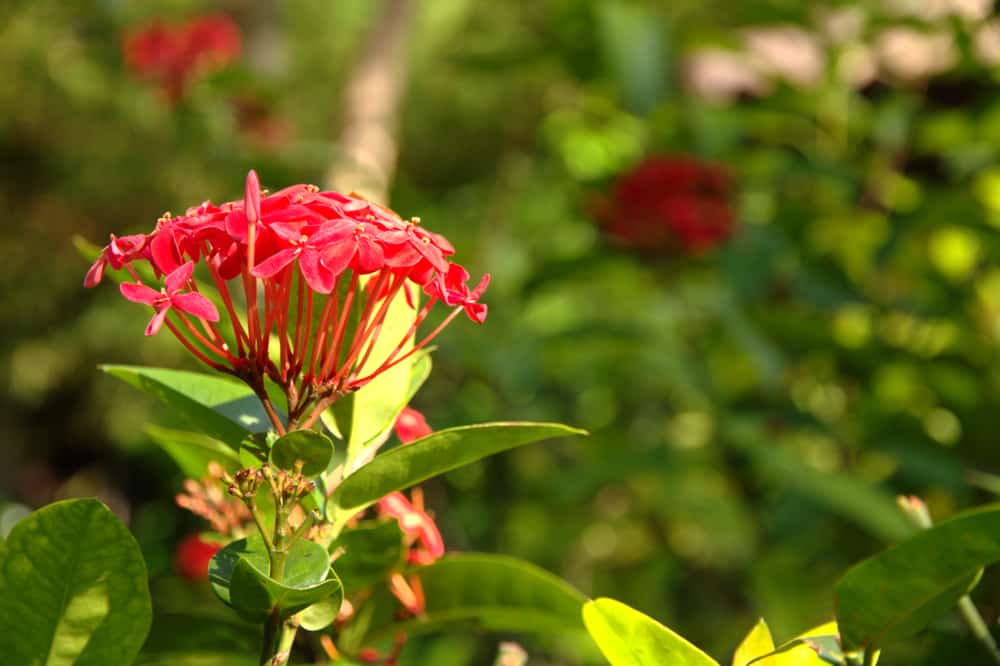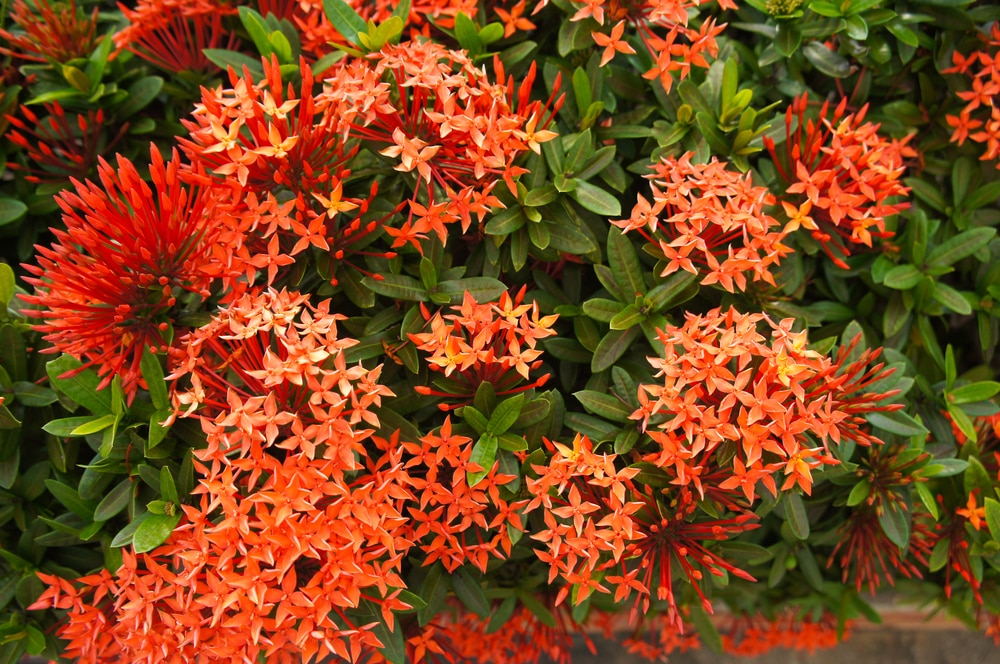Its extravagant little blooms that appear in clusters are Dwarf Ixora’s exceptional feature. It screams tropical and comes in varying colors depending on the species that you want to plant. This tough little bush is perfect for mass planting as a hedge or in containers on your patio.
The Dwarf Ixora is native to Sri Lanka and other parts of Southeast Asia and is a sun-loving plant. But don’t worry if you’re not in one of those areas, these beauties can still be easily grown indoors with the right care.

| Botanical Name | Ixora taiwanensis |
| Common Name | Dwarf Ixora |
| Plant Type | Perennial |
| Flower Color | Scarlet, white, pink, red, and orange |
| Size When Mature | 30-36 Inches |
| Bloom Time | Summer |
| Sun Requirements | Full Direct Sun |
| USDA Hardiness Zones | 9-11 |
| Soil PH Range | 5.0-6.0 |
| Soil Type | Acidic, moist, well-draining |
| Water Needs | Medium |
| Native Area | Sri Lanka and Southeast Asia |
What You Need to Know About Dwarf Ixora
This plant is a dense, evergreen shrub that typically grows to be about 30 to 36 inches tall. It has a rounded compact shape and can spread up to 36 to 48 inches wide. The leaves are dark green, glossy, and oval-shaped with pointed tips.
Dwarf Ixoras bloom fragrant flowers throughout the year, but they typically peak in summer with flowers being small, but they grow in large clusters. They are star-shaped and come in a variety of colors including scarlet, white, pink, red, and orange.
Despite the bright colors, this shrub is non-toxic to humans and animals, making it a great choice for households with children and pets. This plant is relatively easy to care for because of its size and resilience.
It is also low-maintenance, which makes it an ideal choice for those who are new to gardening or do not have a lot of time to care for their plants. It is also possible to grow it as an indoor houseplant.
How to Care for Dwarf Ixora
Here’s everything you need to know about growing and caring for a thriving Dwarf Ixora
Light
When growing Dwarf Ixoras, it is important to plant them in an area where they will receive full direct sun. They prefer well-lit areas and will bloom more profusely when they are in an area with full sun.
If you are growing it indoors, make sure to place it near a window where it can get plenty of light. Rotating your plant is also necessary so that all sides of the plant can receive an equal amount of light.
Water and Soil Needs
They are drought-tolerant and can survive on low to moderate water, but they will bloom best when they are kept moist. During the warmer months, it is necessary to water your plant more frequently and ensure that the soil is evenly moist, but not soggy.
Overwatering can lead to root rot, so it is important to let the soil dry out in between watering. This plant enjoys moist well-draining soil that stays at the acidic pH level of 5.0 to 6.0
Temperature Requirements
This shrub flourishes the most in warm environments so it is important to keep the temperature between 60 to 85 degrees Fahrenheit. If the temperature drops below 60 degrees Fahrenheit, the plant will become dormant and its growth will be stunted. It can survive USDA zones 9 through 11.
Fertilizer
The best fertilizer to use on a Dwarf Ixora is an acidic granular fertilizer. It needs to contain a good amount of nitrogen, phosphorous, and potassium. You can find these nutrients in many all-purpose fertilizer brands that are meant for acid-loving plants. Feeding should be done regularly when the plant is actively growing during spring, fall, and summer.
Common Diseases
These plants have few pest and disease problems. Some of the most common include aphids, scale insects, and mealy bugs. These pests do damage by sucking the sap from the leaves, which can stunt growth, and cause leaf drops.
Sooty molds would soon follow as these pests excrete a sticky substance that will coat the leaves and turn black. Solving the infestation with horticultural oils or insecticidal soaps is the best way to get rid of these pests and will then eventually solve the sooty mold problem.
Dwarf Ixora Propagation
Propagating this plant can be easy as ABC. With just a little effort and patience, you can have more of these beautiful shrubs in no time. The best way to propagate a Dwarf Ixora is through stem cuttings. To do this, you can start by cutting a 4- to 6-inch stem from the tip of a healthy mature plant using sterilized pruning shears.
Remove the bottom leaves of the stem, leaving only 2 or 3 leaves at the top. Dip the cut end of the stem in rooting hormone powder and then plant it in a pot and place it in an area where it will receive indirect sunlight. Keep the soil moist at all times. It can take several weeks for roots to form, but once they do, you will see new growth starting to develop.

